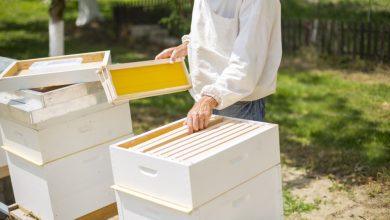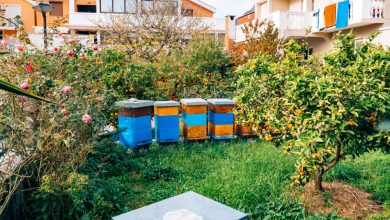Where Do Beekeepers Keep Their Bees
Beekeepers keep their bees in a designated area called an apiary or “bee yard.” These apiaries can be found in various locations, both rural and urban.
Traditionally, beekeepers maintained wild bee colonies in artificial hives made from materials like logs, boxes, vessels, and baskets.
However, with advancements in beekeeping techniques, movable comb hives made of wood or polystyrene are now commonly used.
These hives consist of floors, brood-boxes, honey supers, crown-boards, and roofs.
Some beekeepers also utilize the Flow Hive system, which allows for easy honey extraction.
While large beekeeping operations are typically agricultural businesses, there is a growing trend of urban beekeeping, where studies suggest that city-kept bees may benefit from fewer pesticides and greater biodiversity.
Did You Know?
1. The answer to the question “Where do beekeepers keep their bees?” may vary depending on different beekeeping practices, but one surprising fact is that some beekeepers choose to keep their hives on rooftops in urban areas. This method, known as urban beekeeping, has been gaining popularity as an innovative way to support pollination in cities.
2. You might have heard of beekeeping in traditional wooden hives, but did you know that some beekeepers use unconventional materials? One example is the use of glass hives, which allow beekeepers to observe the fascinating activities of the bees without disturbing them and provide an aesthetically pleasing approach to beekeeping.
3. Beekeeping is not limited to the warm and sunny regions of the world. In fact, some beekeepers, particularly in colder climates, utilize specially designed hives equipped with insulation to protect the bees during winter months. This allows beekeeping to occur in regions that might otherwise be inhospitable for bees.
4. While honey is the most well-known product derived from beekeeping, there is another lesser-known substance that can be harvested from hives: bee pollen. Bee pollen, which is collected by bees as a source of protein, has become popular as a nutritional supplement due to its high content of vitamins, minerals, and antioxidants.
5. Bees are resourceful insects, and that extends to their choice of habitat. In addition to the commonly associated wooden hives, there are instances where bees have sought alternative locations to build their hives, such as inside hollowed-out trees, abandoned buildings, or even in man-made structures like old cars or water meters. This adaptability showcases the ingenuity of bees when it comes to finding suitable homes.
The History Of Beekeeping
Beekeeping has a rich and fascinating history that dates back thousands of years. It is believed to have started approximately 10,000 years ago, with Georgia being known as the “cradle of beekeeping.” In fact, the oldest honey ever found, dating back 5,500 years, was discovered in Georgia. Evidence of beekeeping can also be seen in ancient Egyptian art, and it was practiced in ancient China, Greece, and Maya as well.
In the early days, humans attempted to maintain wild bee colonies in artificial hives made from various materials such as hollow logs, wooden boxes, pottery vessels, and woven straw baskets known as skeps. However, it was not until the 18th century that European understanding of bee colonies and biology allowed for the construction of movable comb hives. These hives enabled honey harvesting without destroying the entire colony and marked a major milestone in the development of beekeeping techniques.
The Benefits Of Urban Beekeeping
Urban beekeeping is a growing trend that involves keeping honeybees in urban and suburban environments, such as rooftops, balconies, or backyard apiaries. This practice has several benefits and opportunities:
-
Improved health of the bees: In urban areas, there is generally less pesticide use compared to rural areas, creating a healthier environment for the bees. Additionally, the diversity of plants in cities provides a rich source of nectar and pollen, contributing to stronger and healthier colonies that are more resistant to diseases.
-
Connecting with nature and learning about sustainability: Urban beekeeping allows city dwellers to interact with nature and gain knowledge about sustainable practices. It raises awareness about the importance of pollinators and their crucial role in maintaining ecosystem balance.
-
Supporting local honey production: By keeping bees in urban areas, beekeepers can contribute to the local honey production. This supports local businesses and promotes sustainable agriculture.
In conclusion, urban beekeeping is an effective way to benefit the health of bees, raise environmental awareness, and support local honey production.
Different Types Of Beehives
Beekeepers keep their bees in specialized structures called beehives or apiaries. These hives come in various types, each with its own advantages and characteristics.
Traditionally, hives were constructed from cedar, pine, or cypress wood. They typically have a box-like structure with different components. The basic components include:
- A floor
- A brood-box
- A honey super
- A crown-board
- A roof
The brood-box is where the queen lays her eggs and the worker bees raise the brood. The honey super is added when the bees need excess space to store honey. The crown-board acts as a cover for the hive, while the roof protects the hive from the elements.
In recent years, polystyrene hives have gained popularity due to their insulation properties and durability. These hives provide better protection against extreme weather conditions, offering a more stable environment for the bees.
Additionally, there have been innovative advancements in hive designs. The Flow Hive system, invented in Australia in 2015, revolutionized honey extraction. It allows beekeepers to harvest honey easily without the need for centrifuge equipment. This system involves specially designed frames that allow the honey to flow out directly into jars, making the extraction process less invasive for the bees and more efficient for the beekeeper.
- Polystyrene hives offer better insulation and durability
- The Flow Hive system revolutionized honey extraction by allowing honey to flow directly into jars without centrifuge equipment.
Modern Innovations In Beekeeping
Beekeeping has embraced queen excluders as a modern innovation to enhance efficiency and sustainability. These specialized grids are placed between the brood-box and honey supers, allowing worker bees to pass through while preventing the larger queen from entering the honey supers. This ensures that the honey produced in the supers remains free of brood and queen cells.
Another significant innovation is the replacement of hive floors with wire mesh and removable trays. This modification is necessary due to the presence of mite pests, such as Varroa destructor, which weaken bee colonies. The wire mesh and trays enable beekeepers to monitor and control the mite population more effectively.
In addition, the introduction of modern beekeeping equipment and tools has greatly improved the handling and management of beehives. From protective clothing to hive tools and smokers, beekeepers now have access to a range of specialized equipment designed to make their work safer and more efficient.
Regional Variations In Beekeeping Practices
Beekeeping practices can vary significantly across different regions and countries. Each region’s unique environmental conditions, cultural traditions, and bee species influence the preferred methods and hive designs employed by beekeepers.
For example, in Scandinavian countries and Russia, the traditional trough hive was commonly used until the late 20th century. This type of hive consists of a long, horizontal log with hollowed-out sections that serve as individual cavities for the bees. Despite its historical significance, the trough hive has largely been replaced by more modern hive designs in these regions.
Similarly, regions with abundant bamboo resources have developed hive designs using bamboo materials. These hives provide a sustainable and affordable alternative, leveraging the natural properties of bamboo.
In tropical regions, where bees face unique challenges such as high temperatures and humidity, beekeepers adapt their practices accordingly. They may use hives with improved ventilation or incorporate shade structures to help regulate the temperature and create a more favorable environment for the bees.
These regional variations highlight the adaptability of beekeeping practices and the importance of tailoring techniques to suit specific environments and bee species. By understanding and respecting regional variations, beekeepers can optimize the health and productivity of their colonies.
Beekeeping has a long history and plays various roles beyond honey production. Urban beekeeping, for instance, has gained popularity due to its benefits for both bees and the environment. Different types of beehives, such as traditional wooden hives and modern polystyrene hives, cater to the specific needs of the bees and beekeepers. Modern innovations, including queen excluders and wire mesh floors, contribute to improved bee health and hive management.
Lastly, regional variations in beekeeping practices highlight the diversity and adaptability of this ancient art. Beekeepers around the world continue to find innovative ways to protect and nurture their colonies for the benefit of humans and bees alike.
Check this out:
Frequently Asked Questions
What is the name of bee’s house?
The name of the bee’s house is referred to as a beehive. It is specifically built and inhabited by honey bee species of the subgenus Apis, serving as an enclosed structure where they live and rear their offspring. While the term “beehive” is commonly used to describe any bee colony’s nest, scientific and professional literature make a distinction between a nest and a hive.
What is a bee box called?
A bee box is commonly referred to as a hive box. It serves as the dwelling for bees, providing them with a secure and organized space to build their colony. Within the hive box, multiple frames are placed, usually made of wood or plastic, allowing the bees to construct comb and store honey. The hive box also acts as a brood chamber, providing a suitable environment for the queen bee to lay eggs and for the larvae to develop into worker bees or future queens. Overall, the hive box plays a critical role in supporting the life cycle and activities of a bee colony.
How do beekeepers keep bees?
Beekeepers maintain the well-being of bees by providing them with the necessary resources and support. They start by offering hives which act as shelters for the bees, enabling them to establish their colonies and protect themselves. Additionally, beekeepers understand the importance of medication and offer it to the bees when required, ensuring their health and protection against potential diseases. While beekeepers play an essential role in beekeeping, it is noteworthy that bees are remarkably adept at meeting their own needs, displaying a remarkable ability to self-sustain and navigate their environment with minimal intervention.
Where are bees stored?
Bees are stored in apiaries, which are essentially bee yards where beehives are kept. These apiaries can be found in various locations, ranging from rural areas to urban settings, depending on the purpose of honey production. They can be used for commercial operations, educational purposes, or even as a hobbyist’s hives. Regardless of the setting, the apiary serves as a central location for storing and maintaining these precious honey bees.

